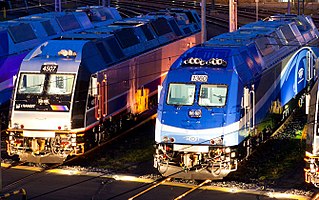
An electro-diesel locomotive is a type of locomotive that can be powered either from an electricity supply or by using the onboard diesel engine. For the most part, these locomotives are built to serve regional, niche markets with a very specific purpose.

Prima is a family of railway diesel and electric locomotives built by Alstom. Manufacture of the type commenced in the late 1990s. By 2008, Alstom had reportedly sold 1,750 Prima locomotives. The second generation Prima II was launched in 2009. The Prima H3 diesel/battery hybrid locomotive was launched in 2013.

The Electro-Motive Diesel (EMD) Class 66 are Co-Co diesel locomotives built by EMD for the European heavy freight market. Designed for use in Great Britain as the British Rail Class 66, a development of the Class 59, they have been adapted and certified for use in other European countries. Outside Europe, 40 locomotives have been sold to Egyptian Railways for passenger operation.

Stadler Rail is a Swiss manufacturer of railway rolling stock, with an original emphasis on regional train multiple units and trams, but moving also into underground, high speed, intercity and sleeper trains. It is also producing niche products, such as being one of the last European manufacturers of rack railway rolling stock. Stadler Rail is headquartered at its place of origin in Bussnang, Switzerland. Stadler Rail employed 13,400 employees by 2022.

The Alstom PL42AC is a class of four axle B-B diesel-electric locomotive designed by Alstom in association with GM-EMD. 33 were built between 2003 and 2006 for NJ Transit Rail Operations.

The British Rail Class 88 is a type of mainline mixed traffic electro-diesel locomotive manufactured by Vossloh España/Stadler Rail Valencia for Direct Rail Services (DRS) in the United Kingdom. The locomotive is part of the Stadler Euro Dual family. It is the first dual-mode locomotive in the UK to use the 25 kV AC electrification.

The Voith Maxima locomotives are a family of diesel-hydraulic locomotives built by Voith Turbo Lokomotivtechnik GmbH & Co. KG., a subsidiary of Voith.

The Stadler Euro is a class of diesel-electric locomotives built by Stadler Rail for the European market. It is available in two basic variants, the four-axle Euro 3000, and the six-axle Euro 4000. These locomotives are powered by EMD 710 prime movers. A six-axle electric-only variant is marketed as Euro 6000; it is also built for the Iberian gauge.

The Prima Diesel-electric locomotives are a class of medium and heavy, four- and six-axle, passenger and freight mainline locomotives. They have been built both to 1,435 mm standard and 1,668 mm broad gauges, and find use in the Middle East, Europe and North America. Alstom is the primary designer in cooperation with both General Motors and Siemens.

The Eurorunner family of locomotives are a series of medium- to high-power diesel-electric locomotives built by Siemens for the European market. Introduced from 2002 onwards, they share design characteristics with the successful Eurosprinter range of electric locomotives, also built by Siemens.

The Bombardier ALP-45DP is a type of single cab dual-mode locomotive operated by New Jersey Transit and Exo. The locomotive was designed and originally built by Bombardier until 2021, and by Alstom since 2021.

The Vossloh G1000 BB is a class of off-centre cab diesel-hydraulic B'B' 4 axle locomotives built by Vossloh in Kiel since 2002. When operating under Swiss ownership the locomotives have received the class Am 842, several units owned by the Société Nationale des Chemins de Fer Luxembourgeois are classified as CFL class 1100.

The Stadler Eurolight is the brand name for a family of 4-axle Bo'Bo' mainline diesel-electric locomotives with sub-20-tonne axleloads for passenger and freight trains produced by Stadler Rail.

The JT 42BW is a class of four axle Bo'Bo' diesel electric locomotives manufactured by Alstom's Meinfesa plant in Spain for Israel Railways (IR). The locomotives were the primary passenger locomotive unit used by IR through the 2000s.

The Class 68 is a type of mainline mixed traffic diesel-electric locomotive manufactured by Stadler Rail Valencia for Direct Rail Services (DRS) in the United Kingdom. The design is derived from the Stadler Eurolight, and Stadler's product name for this variant is the UKLight.

Beacon Rail is a rolling stock company (ROSCO) based in the United Kingdom. Its primary business is the leasing of locomotives and rolling stock to various train operating companies (TOCs).

The Passenger Rail Agency of South Africa Class Afro 4000 of 2014 is a South African diesel-electric locomotive.

An electro-diesel multiple unit (EDMU) or bi-mode multiple unit (BMU) is a form of a multiple unit train that can be powered either by electric power picked up from the overhead lines or third rail or by using an onboard diesel engine, driving an electric generator, which produces alternating current (AC) or direct current (DC) electric power.

The British Rail Class 93 is a tri-mode locomotive built by Stadler Rail in Valencia. It is an evolution of the Class 88 bi-mode locomotive which was built by Stadler for Direct Rail Services. Three different power sources are used to power the locomotive – 4,000 kW (5,400 hp) 25 kV AC overhead electric power, or a 900 kW (1,200 hp) diesel engine supplemented by a 400 kW (540 hp) battery – allowing the locomotive to be used on both electrified and non-electrified lines.
The British Rail Class 99 is a planned class of dual-mode electro-diesel Co-Co locomotives that will haul freight trains on both electrified and non-electrified lines. It will be based on the Stadler Euro Dual platform.





















